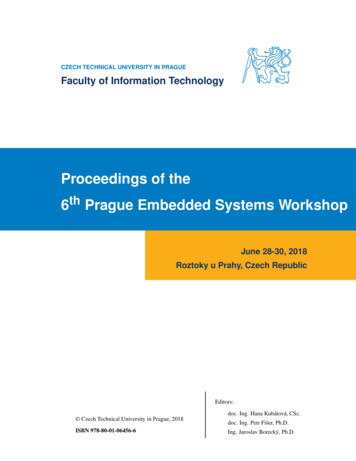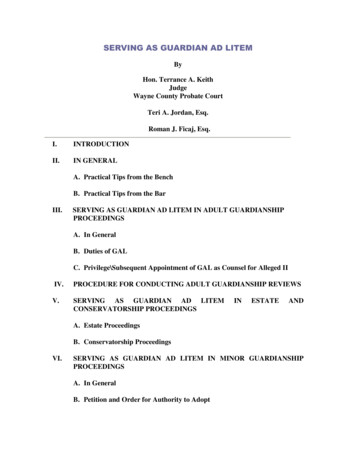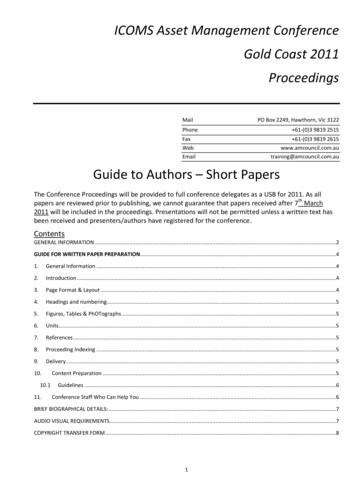
Transcription
CZECH TECHNICAL UNIVERSITY IN PRAGUEFaculty of Information TechnologyProceedings of the6th Prague Embedded Systems WorkshopJune 28-30, 2018Roztoky u Prahy, Czech RepublicEditors: Czech Technical University in Prague, 2018ISBN 978-80-01-06456-6doc. Ing. Hana Kubátová, CSc.doc. Ing. Petr Fišer, Ph.D.Ing. Jaroslav Borecký, Ph.D.
Message from the Program ChairsThe Prague Embedded Systems Workshop is a research meeting intended for the presentation and discussion of students’ results and progress in all aspects of embedded systems design, testing, and applications.It is organized by members of the Department of Digital Design at Faculty of Information Technology(which is the youngest one) of the Czech Technical University in Prague (which is the oldest technicaluniversity in Central Europe). The workshop aims to enhance collaboration between different universitiesnot only inside EU. It will be based on oral presentations, mutual communication, and discussions.Modern embedded devices are equipped with communication interfaces and the importance of securedcommunication grows. Devices are usually connected into a computer network so they become a part ofthe network infrastructure. Besides benefits and advantages, there are security aspects and vulnerabilitiesthat must be covered. Therefore, there is an intersection of design and development of embedded devicesand an area of network security. To follow the current trends and to focus discussions on security topics,PESW organizes a special session on Network security. This section is organized by Tomáš Čejka.There were 21 papers submitted this year, three were full papers and 18 abstracts of long presentations.Therefore, more emphasis was put on presentation, rather than publication, which is the intent of PESW.Papers from Czech Republic, Israel and Italy were present this year.The technical program is also highlighted by four keynote speakers in the areas of testing, reliability,and cybersecurity: Adaptive Test Cost and Quality Optimization. Speaker: Alex Orailoglu Cross-Layer System-Level Reliability Estimation. Speaker: Alberto Bosio Increasing system reliability for safety-critical applications. Speaker: Ernesto Sanchez Cisco is no longer just a networking company. Speaker: Milan HabrcetlThe 6th PESW includes a student competition of the best master and bachelor diploma theses of projectsclose to the embedded systems area. It is organized by the IEEE Student Branch at CTU. PESW programcommittee members will evaluate the posters and their oral presentations to select the best ones. The winnerprizes are sponsored by IEEE, STMicroelectronics, ASICentrum, CZ.NIC, ESET and CESNET.Six technical sessions were formed, with the following topics: Fault tolerance(3 papers) Testing(3 papers) Signal processing(2 papers) Embedded systems, Emerging technologies, Modeling(3 papers) Communication Networks and IoT(3 papers) Stream-Wise Detection and Mitigation(4 papers) Trust and Reputation(3 papers)Last but not least we would like to thank to our sponsors (CTU in Prague, EaToN company, ASICentrum,STMicroelectronics, CZ.NIC, ESET, CESNET and Czechoslovakia Section of IEEE).We wish you to spend fruitful and communicative time in Roztoky.Hana Kubátová and Petr Fišer
CommitteesWorkshop ChairsHana Kubátová, CTU in Prague (CZ)Petr Fišer, CTU in Prague (CZ)Programme CommitteeP. Bernardi, Politecnico di Torino (IT)A. Bosio, LIRMM, Montpellier (FR)T. Čejka, CTU in Prague (CZ)G. Di Natale, LIRMM, Montpellier (FR)P. Fišer, CTU in Prague (CZ)K. Jelemenská, STU Bratislava (SK)P. Kitsos, TEI of Western Greece (GR)H. Kubátová, CTU in Prague (CZ)I. Levin, Tel-Aviv University (Israel)A. McEwan, University of Leicester (UK)M. Novotný, CTU in Prague (CZ)S. Racek, UWB, Pilsen, (CZ)E. Sanchez, Politecnico di Torino (IT)J. Schmidt, CTU in Prague (CZ)M. Skrbek, CTU in Prague (CZ)R. Stojanovic, Univ. of Podgorica (ME)J. Strnadel, BUT, Brno (CZ)R. Ubar, Tallinn Univ. of Technology (EE)H. T. Vierhaus, BTU Cottbus (Germany)Special Session on Network Security ChairTomáš Čejka, CTU in Prague (CZ)Student Poster Session ChairJan Bělohoubek, CTU in Prague (CZ)Organizing CommitteeH. Kubátová, CTU in Prague (CZ)P. Fišer, CTU in Prague (CZ)R. Kinc, AMCA (CZ)E. Uhrová, AMCA (CZ)
ContentsKeynote 1: Increasing system reliability for safety-critical applications . . . . . . . . . . . . . .Ernesto Sanchez, Politecnico di Torino, Italy1Keynote 2: Cisco is no longer just a networking company . . . . . . . . . . . . . . . . . . . . .Milan Habrcetl, Cisco CyberSecurity Specialist, Praha, Czech Rep.1Keynote 3: Cross-Layer System-Level Reliability Estimation . . . . . . . . . . . . . . . . . . .Alberto Bosio, LIRMM Montpellier, France1Keynote 4: Adaptive Test Cost and Quality Optimization . . . . . . . . . . . . . . . . . . . . .Alex Orailoglu, University of California, San Diego, USA2Problems of a Software Test Library for Multicore System-On-Chip . . . . . . . . . . . . . . .Davide Piumatti, Paolo Bernardi, Ernesto Sanchez and Andrea Floridia4Development flow of on-line Software Test Libraries for asynchronous processor cores . . . . .Andrea Floridia and Ernesto Sanchez6ZATPG: SAT-based ATPG for Zero-Aliasing Compaction . . . . . . . . . . . . . . . . . . . . .Robert Hülle, Petr Fišer and Jan Schmidt8A HYBRID DSP/DEEP LEARNING APPROACH TO REAL-TIME FULL-BAND SPEECHENHANCEMENT . . . . . . . . . . . . . . . . . . . . . . . . . . . . . . . . . . . . . . . . .Gabi Shafat, Sagy Harpaz and Avihay Eini11Proposal of Memory Architecture for Pre and Post-Correlation coherent Processing of GNSSSignal with SoC based Acquisition Unit . . . . . . . . . . . . . . . . . . . . . . . . . . . . .Jiří Svatoň, František Vejražka, Pavel Kubalík and Jan Schmidt21Application of Neural Networks for Decision Making and Evaluation of Trust in Ad-hoc Networks . . . . . . . . . . . . . . . . . . . . . . . . . . . . . . . . . . . . . . . . . . . . . . . .Yelena Trofimova26Characterizing IP addresses by predicting their malicious behavior . . . . . . . . . . . . . . .Václav Bartoš28Grouping evil IP addresses . . . . . . . . . . . . . . . . . . . . . . . . . . . . . . . . . . . . . .Lenka Stejskalová and Tomáš Čejka30Fault Tolerance in HLS for the Purposes of Reliable System Design Automation . . . . . . . .Jakub Lojda and Zdeněk Kotásek31Testing Fault Tolerance Properties: Soft-core Processor-based Experimental Robot ControllerJakub Podivínský and Zdeněk Kotásek33Triple Modular Redundancy Used in Field Programmable Neural Networks . . . . . . . . . .Martin Krčma, Richard Pánek and Zdeněk Kotásek35Stream-wise Aggregation of Flow Data . . . . . . . . . . . . . . . . . . . . . . . . . . . . . . .Michal Slabihoudek and Tomáš Čejka37Stream-wise adaptive blacklist filter based on flow data . . . . . . . . . . . . . . . . . . . . . .Filip Šuster and Tomáš Čejka38Penetration Testing & Web Application Intrusion Detection . . . . . . . . . . . . . . . . . . . .Tomáš Ďuračka40
Informed DDoS Mitigation at 100 Gb/s . . . . . . . . . . . . . . . . . . . . . . . . . . . . . . .Tomáš Jánský, Tomáš Čejka, Martin Žádník and Václav Bartoš41P4-to-VHDL: How We Built the Fastest P4 FPGA Device in the World . . . . . . . . . . . . . .Pavel Benáček43Anomaly Detection in the SIoT Gateway . . . . . . . . . . . . . . . . . . . . . . . . . . . . . . .Dominik Soukup45Monitoring network and threats with Turris router . . . . . . . . . . . . . . . . . . . . . . . .Michal Hrušecký46KETCube – the Prototyping and Educational Platform for IoT Nodes . . . . . . . . . . . . . .Jan Bělohoubek47Introduction to logic synthesis of polymorphic electronics . . . . . . . . . . . . . . . . . . . . .Adam Crha49Hybrid enhanced Petri Net model . . . . . . . . . . . . . . . . . . . . . . . . . . . . . . . . . .Almotasem Essa and Zbyněk Jakš50Author Index . . . . . . . . . . . . . . . . . . . . . . . . . . . . . . . . . . . . . . . . . . . . .58Sponsors . . . . . . . . . . . . . . . . . . . . . . . . . . . . . . . . . . . . . . . . . . . . . . .59Partners . . . . . . . . . . . . . . . . . . . . . . . . . . . . . . . . . . . . . . . . . . . . . . . .61
KeynotesIncreasing system reliability for safety-critical applicationsSpeaker: Ernesto Sanchez, Politecnico di Torino, ItalyToday, safety- and mission-critical applications are asking for increasing the system dependability duringthe operational lifetime. Actually, new standards arose in the last years try to define the minimum requestsin order to guarantee reliability of such devices. In fact, during the last years, microprocessor-based safetycritical applications are introducing a series of audit processes to be applied during the whole productlifetime targeting reliability. Some of these processes are common in industrial design and manufacturingflows, including risk analysis, design verification, and validation, performed since the early phases of product development, but very often, additional test processes need to be performed during the product missionlife in a periodic fashion to match reliability standards. In this talk, a brief guideline to effectively increasesystem dependability by exploiting functional approaches is provided. The most important constraints thatneed to be considered during the generation phase, as well as during the execution time are described. Additionally, a comparison checking three different strategies on a particular module of an industrial pipelinedprocessor core is also provided.Ernesto SanchezErnesto Sanchez received his degree in Electronic Engineering from Universidad Javeriana - Bogota, Colombia in 2000. In 2006 he received his Ph.D. degree in Computer Engineering fromthe Politecnico di Torino, where currently, he is an Associate Professor with Dipartimento di Automatica e Informatica. His main research interests include evolutionary computation, functionalmicroprocessor verification, validation, and testing.Cisco is no longer just a networking companySpeaker: Milan Habrcetl, Cisco CyberSecurity Specialist, Praha, Czech Rep.Cybersecurity has become the phenomenon of the present era. Without data protection and infrastructure,it’s hard to achieve of a prosperous business. Let’s have a look how cybersecurity can be more efficient andautomated, and what challenges await us in the near future.Milan HabrcetlSince 1998, he has been deeply involved in cyber security industry, mostly in positions of salesmanager or business development manager. He has been working in Cisco since February 2016within the Global Security Sales organization to support the sales of entire Cisco security portfolioin the Czech Republic and Slovakia.Cross-Layer System-Level Reliability EstimationSpeaker: Alberto Bosio, LIRMM Montpellier, FranceCross-layer approach is becoming the preferred solution when reliability is a concern in the design ofa microprocessor-based system. Nevertheless, deciding how to distribute the error management across1
the different layers of the system is a very complex task that requires the support of dedicated frameworks for cross-layer reliability analysis. In other words, the designer has to know what are the “critical”components of the system in order to properly introduce error management mechanisms. Unfortunately,system-level reliability estimation is a complex task that usually requires huge simulation campaign. Thispresentation aims at proposing a cross-layer system-level reliability analysis framework for soft-errors inmicroprocessor-based systems. The framework exploits a multi-level hybrid Bayesian model to describethe target system and takes advantage of Bayesian inference to estimate different reliability metrics.Experimental results, carried out on different microprocessor architectures (i.e., Intel x86, ARM CortexA15, ARM Cortex-A9), show that the simulation time is significantly lower than state-of-the-art faultinjection experiments with an accuracy high enough to take effective design decision.Alberto BosioAlberto Bosio received the PhD in Computer Engineering from Politecnico di Torino in Italy in2006 and the HDR (Habilitation Diriger les Recherches) in 2015 from the University of Montpellier (France). Currently he is an associate professor in the Laboratory of Informatics, Robotics andMicroelectronics of Montpellier (LIRMM)-University of Montpellier in France. He has publishedarticles in publications spanning diverse disciplines, including memory testing, fault tolerance, diagnosis and functional verification. He is an IEEE member and the chair of the European TestTechnology Technical Council (ETTTC).Adaptive Test Cost and Quality OptimizationSpeaker: Alex Orailoglu, University of California, San Diego, USAThe higher levels of integration and process scaling impose failure behaviors which are challenging to interpret, necessitating the continuous augmentation of fault models and test vectors in the hopes of tamingthe defect escape rate. The subsequent inflation in the number of test vectors coupled with the constantincrease in the size of each test vector continuously boosts test cost. The economics of particularly thecompetitive consumer marketplace however require a constant vigilance at the test cost while ensuring asatisfactory test quality.While the inclusion of new fault models helps boost test quality, the non-uniform distribution of variousdefect types and the defect coverage overlaps between fault models imply variable effectiveness of faultmodels and test vectors, resulting in the inclusion of a large number of ineffective vectors in test flow. Astatic derivation of test effectiveness however remains problematic in practice as it is well known that defect characteristics are prone to drifts throughout the product lifecycle. Furthermore, the increasing processvariation and the integration of hundreds of domains within a chip result in increasingly distinct domainsand individualized chip instances with diverse test resource requirements. The conventional test method ofa static application of an identical test set to all chips consequently struggles to satisfy the demanding testcost and quality constraints in the face of the evolving defect behaviors and the increasing diversificationin test resource requirements.This talk addresses the simultaneous necessity for satisfactory test quality and low test cost through anadaptive test cost and quality optimization framework. The proposed methodologies not only adaptivelyassess the effectiveness of fault models and test vectors but also evaluate the variable test resource requirements of the chips and domains based on their distinct characteristics, enabling an effective yet efficienttest through the selection of the most effective vectors and a carefully crafted allocation of test resources.The proposed methodologies are tailored for a broad set of application scenarios through the considerationof different defect classes and defect characteristic drift types while incorporating the test data gathering2
and delivery constraints and overcoming the associated algorithmic challenges.Alex OrailogluAlex Orailoglu received his S.B. Degree cum laude in applied mathematics from Harvard College,Cambridge, MA, and the M.S. and Ph.D. degrees in computer science from the University of Illinoisat Urbana-Champaign, Urbana.He is currently a Professor of Computer Science and Engineering with the Department of ComputerScience and Engineering, University of California, San Diego, where he directs the Architecture,Reliability and Test (ART) Laboratory, focusing on VLSI test, computer architectures, reliability,embedded processors and systems, and nanoarchitectures. He has published more than 250 papersin these areas.Dr. Orailoglu has served as the General Chair and the Program Chair for the IEEE/ACM/IFIPInternational Symposium on Hardware/Software Codesign and System Synthesis, the IEEE VLSITest Symposium, the IEEE Symposium on Application-Specific Processors (SASP), the Symposium on Integrated Circuits and Systems Design (SBCCI), the IEEE/ACM International Symposium on Nanoscale Architectures (NanoArch), the HiPEAC Workshop on Design for Reliabilityand the IEEE International High Level Design Validation and Test Workshop (HLDVT). He haslast served as the Program Co-Chair of IFIP/IEEE International Conference on Very Large ScaleIntegration (VLSISoC) 2013. He has co-founded the IEEE SASP, the IEEE/ACM NanoArch, theIEEE HLDVT, and the HiPEAC Workshop on Design for Reliability.Professor Orailoglu has served as a member of the IEEE Test Technology Technical Council (TTTC)Executive Committee, as the Vice Chair of TTTC, as the Chair of the Test Technology EducationProgram group, as the Technical Activities Committee Chair and the Planning Co-Chair of TTTCand as the Communities Chair of the IEEE Computer Society Technical Activities Board. He is thefounding chair of the IEEE Computer Society Task Force on Hardware/ Software Codesign and thefounding vice-chair of the IEEE Computer Society Technical Committee on NanoArchitectures.Dr. Orailoglu has served as an IEEE Computer Society Distinguished Lecturer. He is a Golden CoreMember of the IEEE Computer Society.3
Problems of a Software Test Library for Multicore System-On-ChipPaolo Bernardi, Andrea Floridia, Davide Piumatti, Ernesto SanchezPolitecnico di Torino – Dipartimento di Automatica e InformaticaCorso Duca degli Abruzzi 24, Torino ito.itKeywords. Parallel test. In-field testing. Multi-core Software-Based Self-Test.AbstractIn recent years the complexity of System-On-Chips growth exponentially, mainly due to the everincreasing demand for more functionalities, even for embedded applications. In order to fulfil suchrequests, semiconductor vendors introduced in this market multi-core devices to satisfy the morecomplex software algorithms use to image recognition for implementing the Advanced DriverAssistance Systems. However, despite the gain in terms of performance, the adoption of multi-coredevices poses several issues from the test point of view. In particular, it is necessary to evolve the infield test strategies (commonly used to increase the reliability level of a processor-based system) fromthe single core to the multi-core case. We present a possible approach for rapidly migrating a SoftwareTest Library (STL), developed according the Software-Based Self-Test (SBST) approach for a singlecore processor, to a multi-core processor. The solution proposed use the hardware semaphores in orderto control the access to shared resources among different cores. This approach requiring a minimalmodification of the test programs, yet without affecting the fault coverage detected by the STL. Thehardware semaphores were exploited in order to implement the parallel execution of the programsamong different cores, a precalculated scheduler order is need to optimize the total execution time of allSTL on all core of the microcontroller.1.1 Multi core programming and Scheduling problems for the STLIn literature are present different approach to executing a STL in parallel on different cores integratedin the same chip. Initially, it is necessary to distinguish among the multiprocessor chip (CMP) [1] andmultithread chip (CMT) [3] architecture. The first type is composed of N replicas of the same core. Inthe CMP chip the different cores communicated through a shared memories hierarchy, in [2] a possibletechnique of parallel test suite is proposed. The solution is based on a shared two-level cache memoryhierarchy, al L1 private and a L2 shared, for executing the STL and for reduce the access to the flashmemory. A scheduling algorithm is also proposed for reducing the execution time. In the CMTarchitecture, a particular mechanism allows a fast contest switch between two threads in execution. Thisis possible because a few hardware units inside of the core are duplicated (as the register file or the cachememory) and a selector enable the copy associated to the thread currently in execution. In [4] a methodfor splitting test routines among the available threads is proposed, aiming at reducing the core idleintervals. In [5] a methodology targeting both optimization of test execution time and improvement ofthe fault coverage is described. In the case in question uses a CMP chip with the use of hardwaresemaphores to synchronize the cores.4
Multi-core systems often include some hardware resources shared among different cores asmemories or peripherals. It is necessary a safe mechanism for controlling the access to such resources.Possible mechanism are hardware semaphores that implement a simple mode to "lock and unlock" theshared hardware resources. The same STL software, in parallel execution on different cores, uses thesemaphores for acquire temporary exclusive use. The others core remains in wait state until the resourceis not released. In general, a hardware semaphore must guarantee the exclusive use to the resource onlyto the processor that has executed the "lock" operation and forbid the "lock" operation to the othersprocess. Moreover, the processor locking a particular shared resource is the only one that can unlock it.From the programmer’s perspective, hardware semaphores are seen just like a peripheral. The basicoperations that can be performed on a semaphore are the CheckStatusLock, the LockSem and theUnlockSem. The CheckStatusLock is useful to checks whether a particular semaphore is locked or not,while the LockSem and UnlockSem are useful for implementer the "lock and unlock" mechanismprevious described.Traditional scheduling algorithms are not applicable in the STL case, since all tests must beperformed on all system cores. In general, traditional planning considers the activity performed when itis entirely performed on only one core. This constraint increases the complexity of the problem. Inaddition, the problem of shared resources must be considered to avoid waiting states between two ormore processes. In general, the STL is executed at system startup, first on the execution of the operatingsystem or customer code. In boot-time no other codes are executed and a precalculated optimized testorder are scheduling. Aim of scheduling is to reduce the total execution time on all the cores.1.2 ConclusionWe proposed approach for migrating a STL, originally developed for only one of the corescomposing a multi-core SoC, to the whole set of cores. The proposed methodology requires only theavailability of hardware semaphores in order to enable the concurrent execution of test programs amongdifferent cores. The approach does not impact to the fault coverage and required to easy modify to theSTL code for use the semaphores. Clearly, the higher the number of test programs composing the STLand the higher the number of conflicts among them for use the shared resources. In this situation isharder is to find the optimal solution that reduces the overall test execution time.Paper originParallel Software-Based Self-Test suite for Multi-core System-on-Chip: migration from single-core tomulti-core automotive microcontrollers. A. Floridia, D. Piumatti, E. Sanchez, S. De Luca, A. SansonettiThis paper has been accepted and presented at the 13th IEEE International Conference on” Design &Technology of Integrated Systems in Nanoscale Era” (DTIS) 2018 April 10-12, 2018, Taormina, Italy.References[1] Hammond, Nayfeh, Olukotun, “A single-chip multiprocessor”, Computer, Vol. 30, Issue 9, Sep. 1997, pp 79– 85[2] Apostolakis, Gizopoulos, Psarakis, Paschalis, “Software-Based Self-Testing of Symmetric Shared-MemoryMultiprocessors”, IEEE Transactions on Computers, Dec. 2009, Vol. 58, Issue 12, pp. 1682 - 1694[3] Chaudhry, Cypher, Ekman, Karlsson, Landin, Yip, Tremblay, “Rolc: A High-Performance Sparc CMTProcessor”, IEEE Micro, Apr. 2009, Vol. 29, Issue 2[4] Apostolakis, Psarakis, Gizopoulos, Paschalis, Parulkar, “Exploiting Thread-Level Parallelism in FunctionalSelf-Testing of CMT Processors”, Test Symposium, 2009 14th IEEE European, 25-29 May 2009[5] Foutris, Psarakis, Gizopoulos, Apostolakis, Vera, Gonzalez, “MT-SBST: Self-Test Optimization inMultithreaded Multicore Architectures”, IEEE International Test Conference (ITC), 2-4 Nov. 2010, Austin,TX (USA)5
Development flow of on-line Software Test Libraries for asynchronousprocessor coresAndrea Floridia, Ernesto SanchezPolitecnico di TorinoTorino, ito.itKeywords. Software-Based Self-Test, on-line testing, desynchronization.AbstractAsynchronous design style is quite appealing from different perspectives. Several studies confirmedthe reliability of asynchronous circuits in harsh environments, being capable to better tolerate powersupply and temperature variations with respect to the synchronous counterparts. However, despite theseadvantages and many others, their applicability (especially in safety-critical scenarios) is today quitelimited. In addition, commercial EDA tools can be hardly applied to most of the asynchronous designs;therefore, designers are discouraged to use such devices in their applications. Notably, devices deployedfor safety-critical applications must satisfy stringent requirements to guarantee the highest reliabilitylevel, defined for example in the ISO 26262 standard for automotive applications. Commonly, on-linetesting mechanisms are necessary to achieve such requirements (e.g., On-line Built-in Self-Test,Lockstep Execution, and Software Test Libraries). Such mechanisms undergo several validationprocesses to assess their effectiveness, being fault injection campaigns the most commonly used. It isimportant to note that for such procedures, designers exploit standardized commercial EDA tools,intended to certificate standards compliance. In this study, we describe a methodology for thedevelopment and the evaluation of Software Test Libraries (STLs) targeting the on-line testing ofasynchronous processor cores, using exclusively commercial tools used by industries for the functionalsafety analysis. Currently, we are targeting stuck-at faults, but the proposed flow can be extended toother fault models. The proposed flow starts from a synchronous processor core; then, a preliminarystep consisting in the desynchronization [2] of the processor is performed. The selected designmethodology is fully compatible with EDA tools and it does not require a detailed knowledge ofasynchronous design. Concerning the STL, these programs are developed according to the SoftwareBased Self-Test (SBST) approach. Our case study is the DLX processor used in the ASPIDA [1] project.In the literature, there exist many SBST strategies targeting synchronous-based processor cores, alongwith well-established methodologies for assessing their effectiveness. For synchronous processors, thefault simulator, for example, is instructed to periodically observe some meaningful system bus signalsat specific time instants (hereinafter strobe points). In those time instants, the processor is supposed tostore the signature produced by the test program execution in the available memory. Each strobe pointis characterized by a period of observation and a time offset. The period of observation, called strobeperiod, is equivalent to the processor clock period, while the time instant in which values should bestable and the signature is being stored into the data memory is called strobe offset. Usually, the strobeoffset is computed so that the observation of such signals is performed very close to the end of the clockperiod, a time instant in which the circuit is supposed to be in a quiescent state (i.e., not switchinganymore). It is worth noting that strobe points are not necessary contiguous time instants (i.e., oneimmediately after the previous). In fact, to reproduce the same scenario of the on-line test, the testengineer should compute strobe offset and period for each strobe point so that system bus signals are6
observed exclusively when they hold the signature (otherwise, too optimistic fault coverages could beobtained). Intuitively, the lack of a clock signal makes the application of such a strategy to asynchronousprocessors not trivial as is. However, the handshake controllers of the desynchronized version behaveas local clock generators for each stage of the processor pipeline. These clocks are the enable signals forthe sequential elements (namely the latches) of the stage they are associated with. Such signals arecontinuously generated by the controllers, according to a given handshake protocol. Thus, by carefullyobserving the behavior of the desynchronized processor, we could conclude that the memory stage ofthe processor is periodically enabled. Indeed, even though the memory access is not actually performed(no valid data present on the bus), the controller generates the enable signals for that stage. Since thisstage interfaces the processor with the data memory, is the only portion of the circuit through which thetest signature can be observed (namely, when it is stored in memory). The data are stored in the slavelatch when the enable signal goes from high to low (mimicking the edge-triggered behavior of asynchronous circuit). Bus data lines are assumed to be stable before slave latch closes. Hence, bysynchronizing the fault simulator with that signal period, it is possible to use the very same methodologyfor the asynchronous processors as well. In the following, the proposed fault simulation flow isdescribed. Starting from the desynchronized processor, both the STL and the processor are simulatedresorting to a commercial logic simulator. From this initial simulation, the strobe points for the faultsimulator are extracted. It is important to note that in a synchronous processor, this step is not requiredsince strobe points are synchronized with the system clock. At this point, the fault simulation campaignbegins. The fault si
Cisco is no longer just a networking company Speaker: Milan Habrcetl, Cisco CyberSecurity Specialist, Praha, Czech Rep. Cybersecurity has become the phenomenon of the present era. Without data protection and infrastructure, it's hard to achieve of a prosperous business. Let's have a look how cybersecurity can be more efficient and










